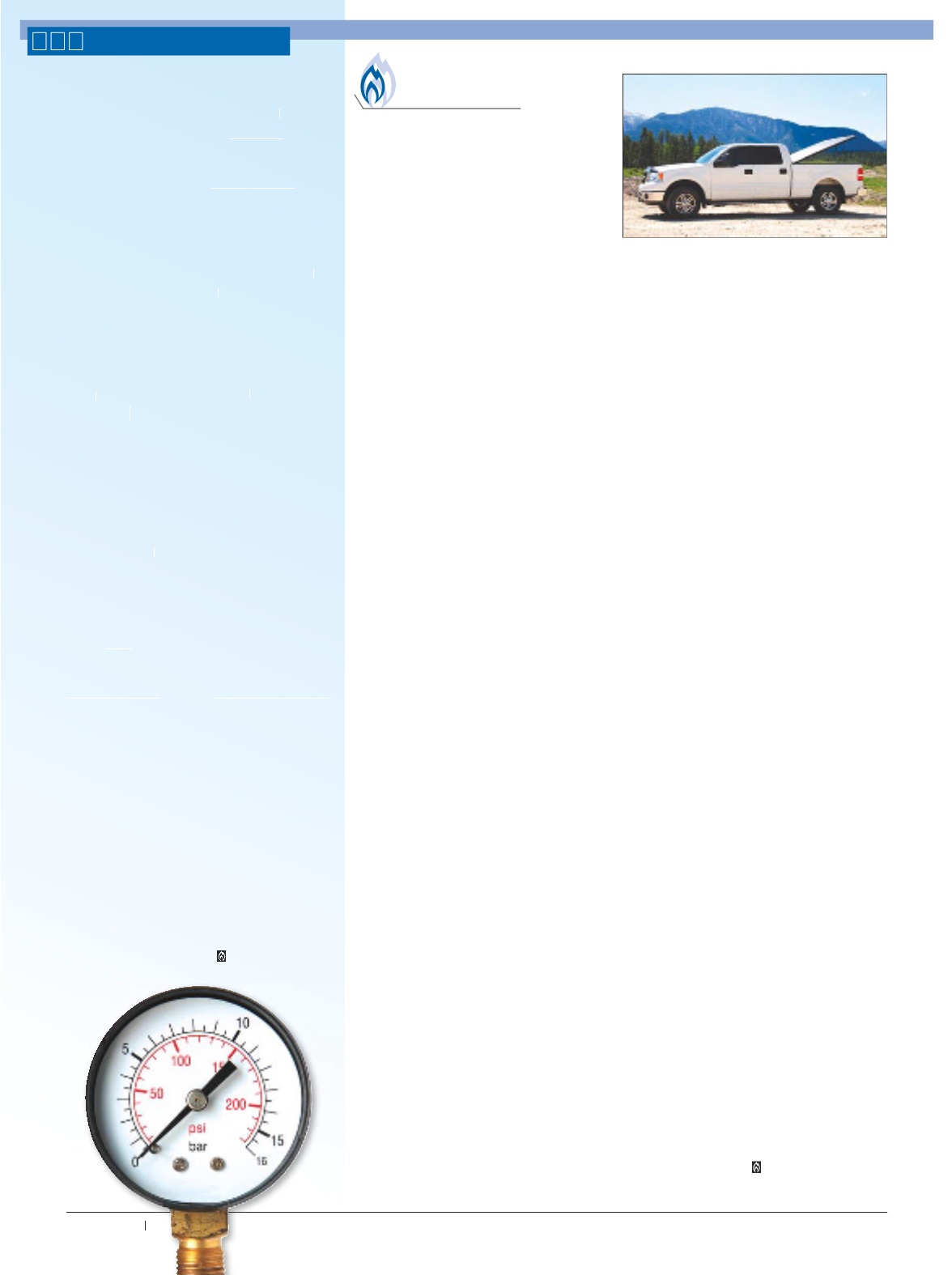
is not turned off all the way, or is leaking
through, and should be replaced. If the
reading decreases, that is an indication that
there is leak in the system.
Testing downstream of the second stage
regulator is done using a water manometer,
an electronic manometer, or pressure gauge
that measures inches of water column (w.c.)
in a port after the outlet of the second stage
regulator. In this case, after the system is
pressurized, the pressure is bled down to 9
inches w.c. and held for 3 minutes. As with
the test above, an increase in pressure indi-
ca
tes a leaking service valve and a decrease
shows a lea
k in the system.
For a test bet
ween the outlet of the first
stage regulator and inlet
of the second stage
regulators, a 0-30 psi gauge
i
s
installed in
the line between the two regulators. I
n this
case, the pressure is reduced by 5 psi and
observed for three minutes. A pressure
increase shows a leaking service valve
or decrease readings show a leak in the
system.
LJ< ;<K<:KFI KF CF:8K< C<8B
No matter which method is used,
if the test g
auge shows a pressure decrease,
there is a leak or
leaks that must be found,
repaired,
and retested
before the system
can be put into
service. Use a c
ombustible
gas detector or leak
detection solutio
n to
locate the leak. Never use any
type of open
flame
or other ignition source to
find a
propane l
eak. Do not operate any electric
switches. Use a s
afety flashlight to help find
the leak(s).
Run the leak test again a
fter repairing
any leaks. Once the test holds pressur
e for
3 minutes, it is safe to place the appliance
into operation.
Once a standard testing method is
decided upon, a leak test is a relatively
simple procedure to perform. After prac-
ticing a few times in the field it becomes
second
nature. In addition to being part of
the require
d code, it is a necessary practice
to ensure a leak-
free installation and the
safety of our customers.
Propane
N?FC<J8C<IJ J:I8D9C< KF
I<GC8:< JLGGCP =IFD G@G<C@E<
A Kinder Morgan pipeline that carries
40 percent of Minnesota’s propane supply
is scheduled to halt shipment this year,
sending suppliers scrambling for new
supply options, according to a recent
report in the
Minneapolis Star Tribune.
The pipeline operator has announced
it will halt propane shipments from
Canada in April on its 1,900-mile
Cochin pipeline, which passes through
Minnesota. Kinder Morgan will reverse
direction on the pipeline and use it to
carry light petroleum condensate from
the United States for use by Canada’s
booming oil industry.
“Propane wholesalers are building
or converting fuel terminals to accept
deliveries by train instead of by pipeline,
expanding propane storage, leasing
more tankers and trying to manage a
more-complicated supply chain,” the
newspaper reports. Propane is a vital
fuel in Minnesota, where it is used exten-
sively for home heating and crop drying,
according to the
Star Tribune
.
9CFJJD8E 9I<8BJ >IFLE; FE
8LKF>8J I<J<8I:? :<EK<I
Blossman Services Inc. (BSI), a subsid-
iary of The BlossmanCompanies, has begun
construction on a new Autogas Research
and Technology Center in Asheville, N.C.,
according to a report in
NGT News
. The
company says the facility will focus on
the testing and development of propane
autogas systems, as well as serve as a locale
for providing technicians with propane
vehicle training. BSI will also provide sup-
port for conversion centers in the U.S. that
install PRINS autogas technologies.
“The Autogas Research and Tech-
nology Center is really another great
step forward for Alliance Autogas and
PRINS,” Bart van Aerle, CEO of PRINS,
told
NGT News
. “It gives the organization
the ability to implement new technolo-
gies faster, therewith bringing new EPA-
certified applications to the U.S. market
more quickly.” Blossman anticipates that
the new center will be open in the spring
of 2014.
8CC@8E:< 8LKF>8J I<:<@M<J <G8
:<IK@=@:8K@FEJ =FI =FI; :FEM<IJ@FEJ
Alliance Autogas has received U.S.
Environmental Protection Agency (EPA)
certifications covering propane vehicle
conversion systems for model-year 2011
and 2014 Ford F-150 pickup trucks. This
announcement follows on the heels of a set
of EPA certifications that Alliance received
in November, for 10 model-year 2012 and
2013 Ford vehicle platforms.
All of these conversion systems are
using Prins’ VSI bi-fuel autogas technology,
as Alliance Autogas is the exclusive dis-
tributor of Prins products in the U.S. The
model-year 2011 and 2014 certifications
reflect Ford F-150s that use the 5.0-liter
engine. Blossman Services Inc., an equip-
ment technology provider for Alliance
Autogas, secured the EPA certifications.
@:FD J<C<:KJ :FEE<:K@:LK :FDG8EP
=FI 8LKF>8J :FEM<IJ@FEJ
Icom North America, a manufacturer of
propane autogas vehicle system technolo-
gies, has tapped auto repair and mainte-
nance services provider Cusson Automotive
Inc. to serve as an Icom distributor and
installer for Connecticut. Based in South
Windsor, Conn., Cusson Automotive, will
outfit everything from passenger vehicles
to heavy-duty trucks and buses with Icom’s
proprietary JTG liquid-injection propane
systems, including the bi-fuel JTG II, JTGhp
and JTG-D products. “Our plan is to put
Connecticut on the map for propane,” Don
Cusson, owner of Cusson Automotive, told
NGT News
.
NFD<E @E GIFG8E< :FLE:@C
E8D<J F==@:<IJ
The National Propane Gas Association’s
(NPGA) Women in Propane Council
recently announced its leadership for 2014,
as follows:
Chair:
Jill Hopkins, Sheldon Gas;
Vice Chair:
Cindy Platz-Belmont, Delta
Liquid Energy;
Treasurer:
Tracy Kirkman,
Ehrhart Propane & Oil;
Past Chair:
Nancy
Coop, Ferrellgas;
Programs and Events
Committee:
Kerri Essington, Ferrell North
America, and Lisa Gerwitz, Delta Liquid
Energy;
Membership Committee:
Lauren
Clark, Bergquist, and Leslie McCraw,
Ferrellgas;
Marketing Committee:
Hayley
Karicofe, AmeriGas.
Propane
K<JK =FI C<8BJ N?<E J<IM@:< @J @EK<IILGK<; ¿
Îä U "
&
ENE
R
GY


